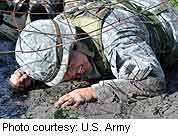
FRIDAY, Sept. 21 (HealthDay News) — Explosions are the main cause of spine injuries among wounded U.S. military personnel, a new study finds.
Researchers analyzed more than eight years of data on back, spinal column and spinal cord injuries suffered by American military personnel serving in Iraq or Afghanistan. Of nearly 11,000 evacuated casualties, about 600 (nearly 5.5 percent) had a total of more than 2,100 spinal injuries.
Explosions accounted for 56 percent of spine injuries, motor vehicle collisions for 29 percent and gunshots for 15 percent, the study found. In 17 percent of spine injuries, the spinal cord also was injured. Fifty-three percent of gunshot wounds to the spine led to a spinal cord injury.
The study also found that 92 percent of all injuries were fractures, 84 percent of patients’ wounds were the result of combat and spinal injuries often were accompanied by abdomen, chest, head and face injuries.
The findings, published Sept. 19 in the Journal of Bone and Joint Surgery, are an important first step in helping orthopedic surgeons develop treatment plans for military personnel with spine injuries, as well as for civilians with similar injuries, according to the researchers.
“In these current military conflicts, the latest technologies in body armor, helmets and other protective devices have helped save many soldiers’ lives,” Dr. James Blair, an orthopedic surgery chief resident at the Brooke Army Medical Center at Fort Sam Houston, in Texas, said in a journal news release.
“We also have access to advanced life-saving techniques in the field and medical evacuation strategies that are keeping many more service members alive,” he added.
“But when a person survives an explosion or vehicle collision, there has still been a great deal of force on the body,” Blair noted. “Many of those survivors are coming to us with severe injuries to their spine and back. We needed to describe and characterize these injuries so recommendations can be made on how to provide the most effective treatment and rehabilitation for our wounded warriors.”
More information
The North American Spine Society has more about spine and spinal cord injuries.

